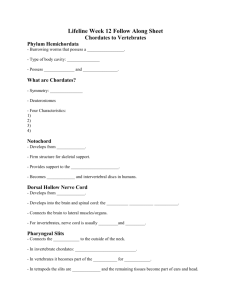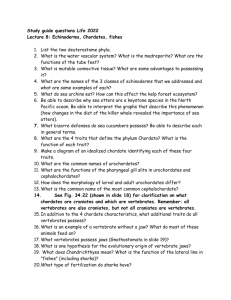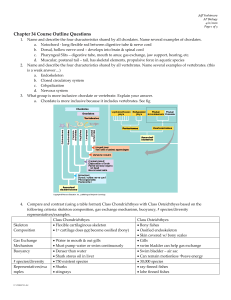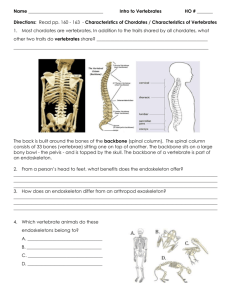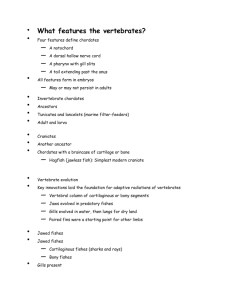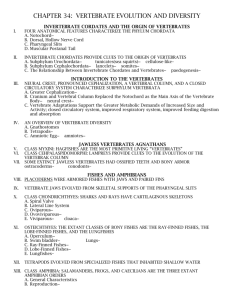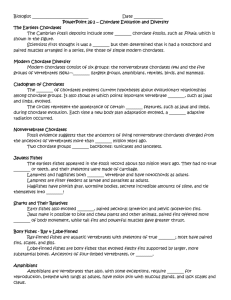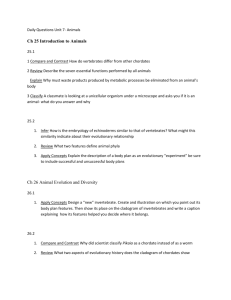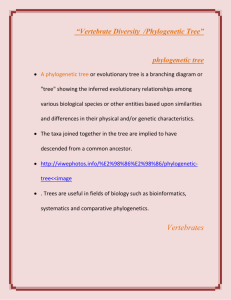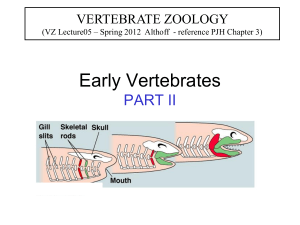Vertebrates - CH 31 Part 1 Notes
advertisement
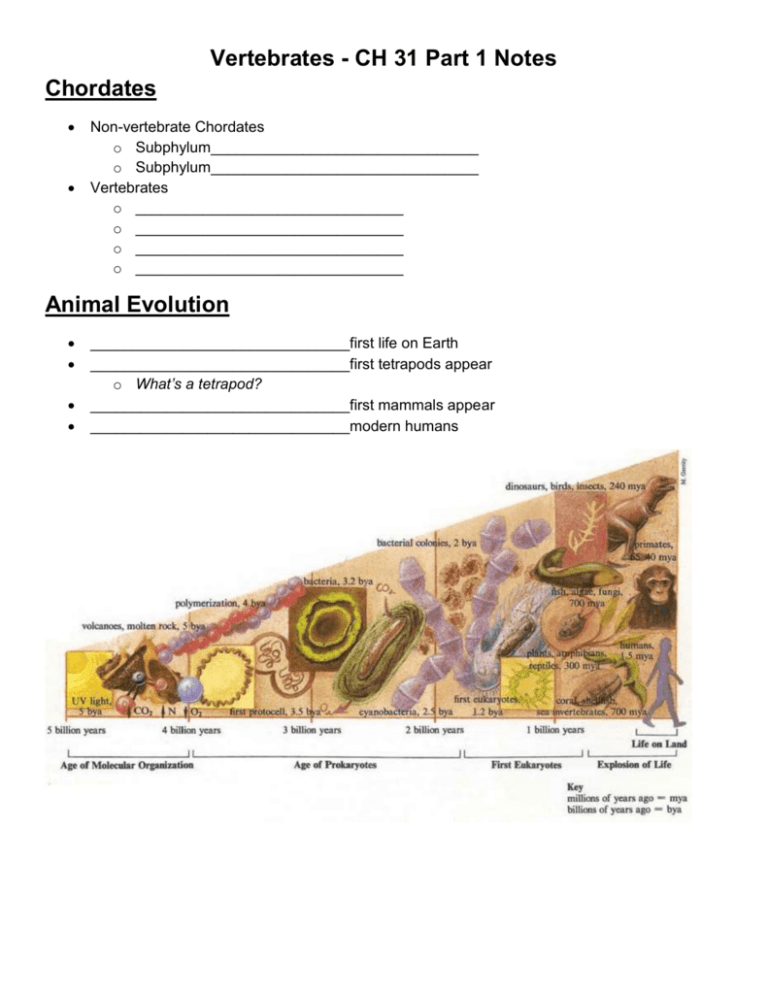
Vertebrates - CH 31 Part 1 Notes Chordates Non-vertebrate Chordates o Subphylum________________________________ o Subphylum________________________________ Vertebrates o ________________________________ o ________________________________ o ________________________________ o ________________________________ Animal Evolution _______________________________first life on Earth _______________________________first tetrapods appear o What’s a tetrapod? _______________________________first mammals appear _______________________________modern humans You should be able to completely fill out this chart (on the right) and the chart for chordates by the end of chapter 31. What differentiates chordates from echinoderms? What is a deuterostome again? Chordates Phylum Chordata Four Main Characteristics ________________ ________________ ________________ ________________ Invertebrate Chordates Notochord persists and is __________________________________________ (Subphylum _________________________) - Lancelets ____________________ (Subphylum _____________________) - Tunicates _________________________ You should be able to completely fill out this chart also (on the left) by the end of chapter 31. What differentiates Invertebrate Chordates and Vertebrates? Hint….look on page 560 and on the next page. Vertebrates Subphylum ______________ Hint ________________________ of vertebrates is ___________________ that grows with the animal Main axis of skeleton consists of _______________________________________________ ___________________ is accompanied by sense organs __________________________________________ _____________________ allows reproduction on land Phylogenetic Tree of Chordates Be careful to only use characteristics discussed in this class and one that are actually on the chart such. What differentiates the 3 types of fishes? How are amphibians and other “higher” vertebrates different? How are reptiles and birds different? What differentiates mammals from other vertebrates? Vertebrate ______________________ with vertebral column ________________ circulatory system _________________ appendages ______________________________________________ High degree of _________________________ Adapted to _______________________________ How have these features allowed vertebrates to grow so large compared with the invertebrates? Vertebrates - CH 31 Part 2 Notes Vertebrata • Hallmarks of vertebrata: At some point have all 4 chordata characteristics: _________________________________________________ ______________________________________________ of cartilage or bone • Vertebrata has over ______________________________ species Fishes _________________________________ __________________________________ Largest group of ___________________; 25,00 species Fishes Jawless fishes (Superclass Agnatha) Ostracoderms - ___________________ _________________________ are modern-day jawless fishes that lack a bony skeleton Gnathostomates have jaws Jaws thought to have evolved from _________________________________ Placoderms Extinct ________________ of Devonian Thought to be ancestral to _____________________________________ Cartilaginous Fishes Class Chondrichthyes have a skeleton of _________________________________________ Cartilaginous Fishes ____________________________ Lack _____________________________ Utilize _____________________________ ____________________________________ Pectoral fins can be enlarged into _______________________________ Bony Fishes Class Osteichthyes have a __________________________ Most are ______________________________ _________________________________________ are small subgroup with ____________________ supported by ________________________ coelacanth Swim bladder _____________________________ in bony fishes Volume can be altered to change _____________________ Tetrapods Tetrapods (_______________________) Hypotheses of ______________________ ____________________________ had an evolutionary advantage due to movement capability further adaptations promoted by: _____________________________ Absence of _____________________ Vertebrates - CH 31 Part 3 Notes Amphibians today occur in three groups all in CLASS -_______________________ __________________________________ __________________________________ ______________________ Most return to ______________________ Most can absorb ______________________ How does this make them susceptible to human activities? Salamanders and newts (not really a classification term) ______________________ Salamanders practice ______________________ Lack ______________________ ______________________, either smooth or covered with tubercles _______ flattened from side to side and often finned. Frogs and toads ______________________ (always?) Most fertilization is ______________________ Frogs – ______________________ Toads – ______________________ Caecilians o ____________________________________________ o _______________________ fertilization o 160 species; most live ______________________ o Eat ______________________ Amphibian Features Usually ___________________________ _____________________ usually present in adults ________________________________ Smooth and moist ________________ (Why?) ________________________ heart ___________________ (What does this mean?) a) b) c) Class Reptilia Thought to have evolved from ____________________________________________ Practice ______________________ Lay eggs protected by a ____________________________________________ (How is this different from amphibian eggs?) Reptiles have a ___________________ that is keratinized and __________________ to water Usually ______________________ Which ones are not? Lungs with ______________________ ____________________________________________(What does this mean?) ______________________ ______________________ (Where would you see this? Vertebrates - CH 31 Part 4 Notes Birds Characteristics of Class Aves _______________________ _______________________ _______________________ _______________________ _______________________ _______________________ Birds Today Approximately ______________________ species – Amphibia ____________ –Reptilia _______________ –Mammalia __________________ • 30 orders, 174 families and 2044 genera Why do you think birds are so successful? Bird Beaks – Why the difference?

